Apr-19-25
 | | KEG: Bogatyrchuk is barely remembered today, but in the early days of the USSR he was an important factor in Soviet championships.
In the instant 1923 tournament (2nd USSR Championship) he tied for third place with Dus-Khotimirsky and Nenarokov behind only Romanovsky and Levenfish;
In the 3rd (1924) Championship; he again tied for 3rd place with Levenfish behind only Bogoljubow and Romanovsky;
After not playing in the Fourth (1925); he shared first place with Romanovsky in the Fifth (1927) USSR Championship ahead of--among others--16 year old Botvinnik;
After sitting out the Sixth Championship, he ended in a four-way tie for 3rd in the 7th (1931) championship behind only Botvinnik and Ryumin;
In the 8th USSR Championship, Bogatyrchuk finished eighth (with a plus 2 score), and inflicted tournament winner Botvinnik with one of only the only two losses he suffered in this event.
Bogatrychuk later defected (there are inconsistent dates for this defection: 1943 and 1948), after which he was deemed persona non grata by the USSR who effaced his name from most tournament records. In the instant game against Lebedev, who tied for the final three places, Bogatrychuk went for the jugular from the outset; quickly becoming fixated on a king-side attack. He apparently thought he could tear poor Lebedev apart, and play by both sides was extremely spotty and sloppy. Throughout, Bogatrychuk played like someone confident of victory who seemingly couldn't be bothered to calculate tactical lines or observe positional niceties. He obviously expected Lebedev to wilt under pressure, and in this he was not to be disappointed. 1. e4 d6
Today this might be the beginning of a Pirc Defense, but Lebedev had other idea. 2. d4 Nd7
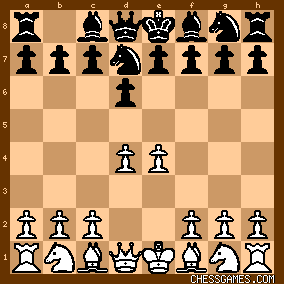
click for larger viewWe now get a version of the Old Indian Defense (i.e., Lebedev having no interests in getting his dark-square Bishop to g7). 3. c4
This was a novelty at the time (so far as I can discover), though the game soon transposes to known lines. 3... e5

click for larger view4. Nf3 Ngf6
5. Nc3
A familiar position (with White holding a small theoretical edge) is now reached. 5... c6
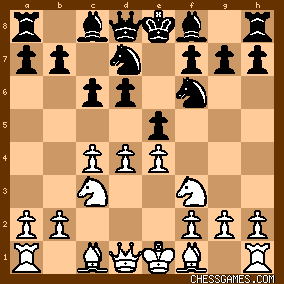
click for larger viewA defensive alignment introduced into master play by Capablanca in 1913. It seems defensive in nature but can be double-edged if wielded by the right player. 6. Be2
The normal response by White:
6... Qc7
Most usual here is 6...Be7, but the text is a harmless transposition that yet again resolves into known lines. 7. 0-0 Be7
Reaching again a known position albeit via an unusual route: 
click for larger view8. h3
To forestall Ng4 by Black.
8... 0-0
9. Be3 Re8

click for larger viewBeginning here, things got weird. |
|
Apr-20-25
 | | KEG: Post II
10. Nd2
Preparing to play 11. f4, Bigatyrchuk did not deign to strengthen his small edge with the positionally superior 11. Qc2 or 11. d5 or even the simple 11. Rc1. 10... Nf8
Lebedev could here have solved most of his problems with the indicated 10...exd4. Instead, already fearing a White King-side assault that was nowhere near fruition, played a hyper-defensive move. 11. f4
All according to plan, and ignoring the much better 11. d5. This left: 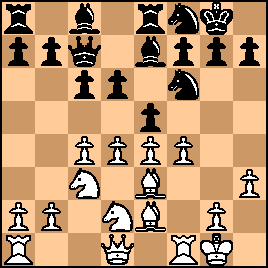
click for larger view11... exf4
A fearful but not terrible response, but Black could have done much better 1ith 11...Ne6. 12. Nxf4 Ng6
13. Bg3 Qb6

click for larger viewWith an x-ray attack on the White King via the a7...g1 diagonal, Lebedev now had nearly equal chances. 14. Nb3 a5
15. a4 Bf8
16. Bd3 Be6
17. Kh1

click for larger viewTelegraphing his attacking plans. He might have considered addressing the position of the Black Queen on the diagonal with 17. Bf2. 17... d5?!
The first sign of life in this game from Lebedev, and not a good one. He could have held his own with 17...Qb4 (my preference) or maybe 17...Be7. The text could have played right into Bogatyrchuk's attacking plans, the position now being: 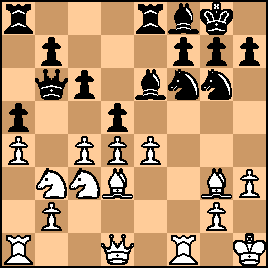
click for larger view18. c5?
A reflexive move that once again gave up most of his advantage which he could have secured with 18. exd5 cxd5 19. c5 [only now!] Qd8 20. Qf3. 18... Qd8
19. e5
Locking up the center, but for what purpose?
19... Nd7
20. Ne2

click for larger view20... Be7
A safe defensive move, but now was surely the time to strike back at Bogatyrchuk's tenuous play with 20...b6. 21. Nf4
Quite ineffective. 21. Qc2 might have applied some meaningful pressure on the Black position. Now Lebedev could seek safety by trading Knights: 21... NxN
22. BxN

click for larger viewLebedev had not played particularly well to this point, but thanks to questionable tactics by Bogatrychuk, he nonetheless had reasonable chances. But beginning here Lebedev began to lose the thread of the game and ruined his prospects. I will discuss how that all came about in my next post on this game. |
|
Apr-20-25
 | | KEG: I should also have mentioned that as late as the 9th USSR Championship, Bogatyrchuk remained a factor in Soviet chess, tying for 3rd place just a half-point behind joint winners Levenfish and I. Rabinovich. All the more strange (and disgraceful) that the Soviets tried to erase Bogatyrchuk from Soviet chess history after his defection to Canada. |
|
Apr-20-25
 | | perfidious: <KEG>, had Bohatirchuk not escaped to Bavaria (the postwar American Zone) after the war under an alias, he would have been tried and probably sent to gulag, or may have wound up on the gallows as a collaborator; one imagines that the Soviets took rather a dim view of his working under the German occupation forces and helping others. The fact that he was PNG'd in their chess press testifies to that. |
|
Apr-21-25
 | | KEG: <perfidious> Excellent points. I should also have mentioned that Bogatyrchuk [there are varying accounts of the spelling of his name] finished third in the 1912 Russian championship and later--in 1954--played for Canada in the 1954 Olympiad achieving a positive score having earlier played in the 1949 and 1951 Canadian national championships. In 1946, Bogatyrchuk played in and won the 1946 displaced person's championship. He dies in 1984 at the age of 91. Quite a varied and interesting resume. |
|
Apr-21-25
 | | KEG: Post III
22... Bg5?
One of the keys to the Old Indian Defense is the defensive placement of his dark-square Bishop on e7. Given White's obvious plan for a King-side assault, facilitating the exchange of this Bishop was a serious positional misjudgment by Lebedev. Instead, he should have gone after White's center pawn mass with 22...b6. 23. Qd2
Stronger for White was 23. Qh5. The text gave Lebedev an opportunity to correct his prior move with 23...Be7 instead of his actual weakening text which soon enough came back to haunt him. Even 23...BxB was better than Lebedev's: 23... h6?
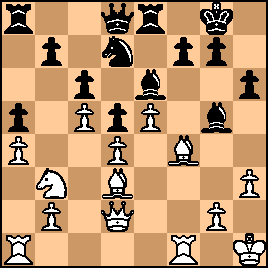
click for larger viewBlack's game is far from lost yet, but the seeds of his undoing have already been sown. 24. Rf3 BxB
25. RxB
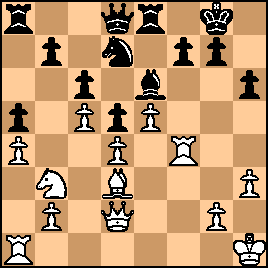
click for larger view25... Nf8?
Another mis-evaluation by Lebedev. Although I hear the words of Ben Finegold in my ears ("never play f6), 25...f6 was Black's best try here. 26. Raf1

click for larger viewBeginning here and for most of the balance of the game, we are treated to a series of tactical errors and missed opportunities by both sides. My teacher Susan Polgar could probably present an intermediate tactics class on the upcoming mistakes. Since Bogatyrchuk was on the offensive, it was Lebedev's errors that proved most costly. 26... Ng6?
This did nothing to impeded the coming White steamroller. He had to try 26...Nh7 or 26...Nd7, although even then Black's game would be difficult. 27. R4f2 Qc7
28. Bb1
Although this didn't ruin White's attacking chances, 28. Rf3 (where he probably should have put the Rook on his last move) was definitely stronger. 28... Nf8

click for larger view29. Nc1
Certainly taking the slow road. Since in many variations White needs to get a Rook to g3, 29. Rf3 was once again best. 29... b6?
Long overdue, and now too late. He had to try 29...Nh7 or maybe 29...Qd8 here. 30. Nd3

click for larger viewLebedev is arguably already lost here. What follows, as I will discuss in my next post on this game, was deplorable. Repeated catastrophic blunders by Lebedev followed by repeated failures by Bogatyrchuk to put Black out of his misery. Not a pretty spectacle. |
|
Apr-22-25
 | | KEG: Post IV
30... Ra7?
Very week. To have much of a chance (even assuming he was not already lost), Lebedev had to try 30...Nh7. The text left: 
click for larger view31. cxb6?
Giving Lebedev new life. 31. Nf4 would have given Bogatyrchuk a devastating attack [e.g., 31...Qd8 32. cxb6 (only now!) Rd7 33. Rf3 with an eventual Rg3 to follow] 31... Qxb6
32. Nf4
Having failed to play Nf4 on his 31st turn, Bogatyrchuk should surely have continued 32. Nc5 now. Lebedev now had a very real chance of holding the game: 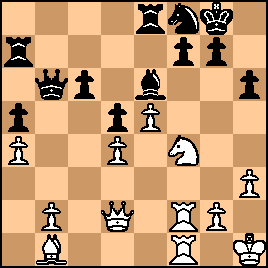
click for larger view32... g6?
An awful and entirely unnecessary weakening of his King-side that should have been immediately fatal. Lebedev should have sought counter-chances if not a Queen trade with 32...Qb4. Alternatively, he could have played the superior defensive move 32...Qd8. Now Bogatyrchuk had a clear winning combo: 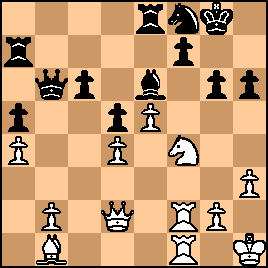
click for larger view33. Rf3
This didn't blow the win, but immediately crushing was 33. Nh5! If then 33...gxN 34. Qxh6 etc. Now Lebedev had some chance or resistance: 
click for larger viewBut, yet again, Lebedev failed to seize his chance: 33... c5?
33...Qb4 offered real prospects of survival. After the text, Bogatyrchuk had another chance to win with Nh5. But: 34. Rg3? Qb4
This left:
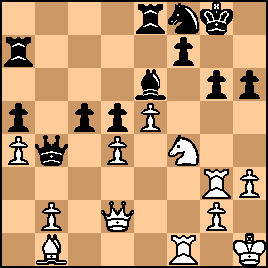
click for larger viewWhite to play and win.
35. Qc1
In fairness to Bogatyrchuk, the gorgeous winning Queen sacrifice is not easy to spot: e.g., 35. Nxg6! fxN [not 35...QxQ 36. Ne7+ and mate next move] 36. Qxh6 Bf7 37. Bxg6 NxB 38. RxN+ BxR 39. QxB+ Rg7 40. QxR+ Kh7 41. Qh6+ after which White's three extra pawns and overwhelming attack are decisive. After the text, the position was:
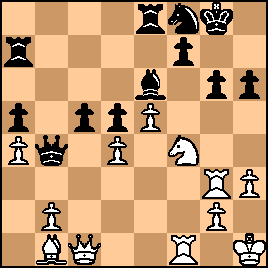
click for larger viewLebedev still had at least practical chances of holding the game. But from here he suffered a total collapse and the game was over within three moves, as I will cover in my next post on this game. |
|
Apr-23-25
 | | KEG: Post V
35... Qxd4?
The only chance to offer any meaningful resistance lay in 35...Qc4. After the text, Bogatrychuk made short work of his opponent, the position now being: 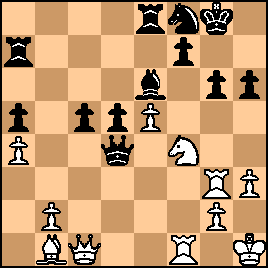
click for larger view36. Nh5!
Decisive:

click for larger view36... Nh7
Hastening the end. But everything else loses as well. If 36...Qxe5 or 36....Qc4, 37. Nf6+ wins. If instead 36...f5 (probably the best available to Black), 37. Nf6+ also wins. 37. Qxh6

click for larger view37... Qxe5
Equivalent to resignation. But, in fairness to Lebedev, he was dead anyway. If instead he had played 37...f5 38. Rxg6+ would still win the game for White. 38. Rxg6+
38. Bxg6 would be even faster, but the text is prettier: 
click for larger view1-0
If now 38...fxR, White cleans house with 39. Qxg6+ leaving Black with the sad choice between giving up his Queen with 39...Qg7 (and still getting mated after a few more moves) or 39...Kh8 40. QxR+ and mate in at most three more moves. A satisfying finish to a sloppy game. |
|
|
|
|





